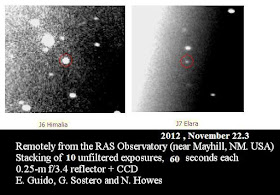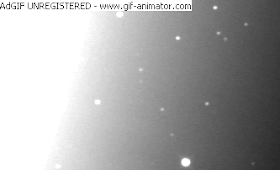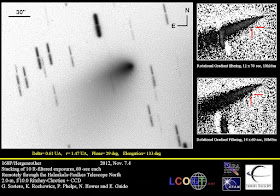The planetary satellites can be distinguished into two characteristic groups: regulars and irregulars. Satellites are classified as “irregular” when their orbits are large, highly elliptical and tilted with respect to the equators of their host planets. In contrast, so-called regular moons, such as Earth’s or the large Galilean satellites of Jupiter, are characterized by small values of semi-major axis, eccentricities and inclinations. Moreover, most of the irregulars have retrograde orbits, which means they move around their host planet in a direction opposite to the sense of the rotation of the planet. While in contrast, regular moons have prograde orbits. Another important characteristic of the irregular ones are the family groups, i.e., satellite groups characterized by similar orbital elements.
This difference can be traced directly to different modes of formation. Whereas the regular satellites grew by accretion within circumplanetary disks, the most plausible hypothesis to explain the origins of the irregular satellites is that they formed elsewhere and were captured by the planet from initially heliocentric orbits at an early epoch. While different capture mechanisms have been suggested (Gas drag capture; Pull-Down capture; Close-approach interaction captures; Capture of binary-asteroids) these bodies are still not well explained by standard models. Studying the origins of irregular satellites is an important piece in the development of the theory of Solar System formation.
This difference can be traced directly to different modes of formation. Whereas the regular satellites grew by accretion within circumplanetary disks, the most plausible hypothesis to explain the origins of the irregular satellites is that they formed elsewhere and were captured by the planet from initially heliocentric orbits at an early epoch. While different capture mechanisms have been suggested (Gas drag capture; Pull-Down capture; Close-approach interaction captures; Capture of binary-asteroids) these bodies are still not well explained by standard models. Studying the origins of irregular satellites is an important piece in the development of the theory of Solar System formation.
Yesterday we imaged 2 irregular satellites of Jupiter: Himalia (Jupiter VI) and Elara (Jupiter VII), both belonging to the "Himalia group". Images were obtained remotely, from H06 (ITelescope network near Mayhill, NM) on 2012, Nov. 22.34, through a 0.25-m f/3.4 reflector + CCD.
Below you can see a diagram showing the semimajor axis scaled to the Hill sphere radius versus orbital inclination, for the irregular satellites of the giant planets known as of November 1, 2006. Also showed is the Himalia group with inclinations between 26.6° and 28.3°, and eccentricities of between 0.11 and 0.25.
 |
| Credit: David Jewitt and Nader Haghighipour - 2007 by Annual Reviews |
Below our image (stack of 10x60seconds exposures) showing both Himalia (magnitude 14.8) and Elara (magnitude 16.1). The bright light in the left corner is from Jupiter. North is up and East is to the left. Click on the image for a bigger version. By clicking here you can see the version without the windows zoom on the satellites.
The graph below (elaborated on IMCCE website) shows the position of Jupiter satellite with respect to Jupiter at the moment of our imaging session. Himalia and Elara are the yellow marked dots. North is up and East is to the left. Click on the image for a bigger version.
Zoom on Himalia & Elara. Click on the image for a bigger version.
Below you can see an animation (spanning about 20 minutes) showing the movement of Himalia. Click on the thumbnail for a bigger version:
Below you can see an animation (spanning about 20 minutes) showing the movement of Elara. Click on the thumbnail for a bigger version:
Ernesto Guido & Nick Howes, for our friend/colleague Giovanni Sostero, who inspires us always, waiting for his recovery.


















